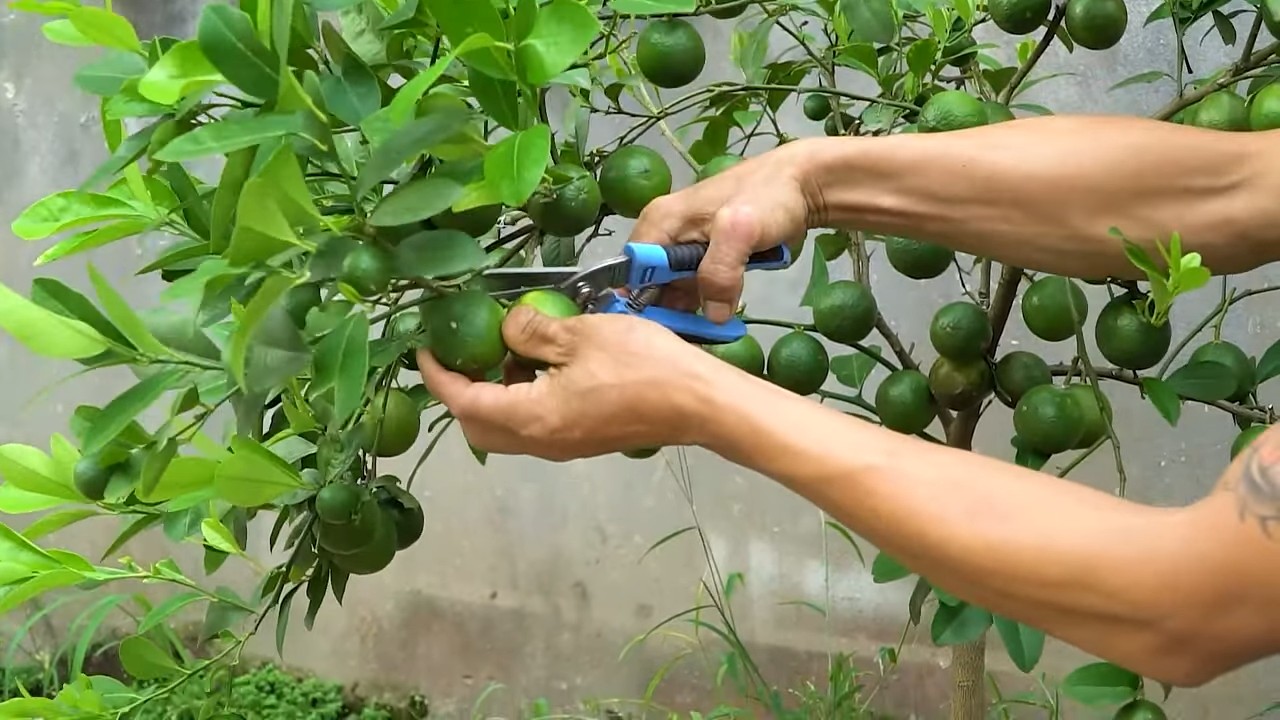Growing Lemons Indoors might seem like a far-fetched dream, especially if you don’t live in a sunny citrus grove. But guess what? It’s totally achievable, and I’m here to show you how! For centuries, cultivating citrus fruits has been a symbol of prosperity and sunshine, bringing a touch of the Mediterranean to colder climates. Think of the elaborate orangeries of European royalty, designed specifically to nurture these precious fruits.
But you don’t need a palace to enjoy the zesty goodness of homegrown lemons. In today’s busy world, having fresh, organic lemons at your fingertips is a game-changer. Imagine adding a splash of sunshine to your morning tea, baking a delicious lemon cake with ingredients you nurtured yourself, or even just enjoying the vibrant fragrance of lemon blossoms filling your home.
This DIY guide is packed with simple, effective tricks and hacks that will empower you to successfully grow lemons indoors, regardless of your experience level. Forget complicated gardening jargon and expensive equipment. I’ll walk you through everything you need to know, from choosing the right variety to providing the perfect light and nutrients. So, let’s embark on this exciting journey and unlock the secrets to growing lemons indoors, bringing a little bit of sunshine into your life, one lemon at a time!

Growing Lemons Indoors: Your Comprehensive DIY Guide
Hello plant friends! Have you ever imagined harvesting your own sun-ripened lemons, right in the middle of winter, directly in your living room? Sounds crazy, right? But it’s absolutely doable! I’ll show you how to grow lemons indoors, from selecting the right variety to harvesting the first fruits. It’s a bit of work, but the taste of a homegrown lemon is simply unbeatable. Let’s get started!
The Basics: What You Need
Before we begin, here is a list of the things you’ll need for your indoor lemon project:
- Lemon tree variety: Not all lemon trees are the same. Choose a variety that is well-suited for growing in a pot. Popular options include ‘Meyer’, ‘Lisbon’, or ‘Eureka’. I have personally had very good experiences with ‘Meyer’, as they stay relatively small and bear fruit early.
- Pot: A sufficiently large pot is crucial. Start with a pot at least 30 cm (12 inches) in diameter and 30 cm (12 inches) deep. You can always repot later when the tree gets bigger. Make sure the pot has drainage holes so excess water can run off.
- Soil: Lemon trees need well-draining, slightly acidic soil. A special citrus potting mix is ideal, but you can also use a mixture of potting soil, sand, and perlite.
- Fertilizer: Lemon trees are hungry! You’ll need a citrus fertilizer that is rich in nitrogen, phosphorus, and potassium.
- Light: Lemon trees need a lot of light, at least 6-8 hours of direct sunlight per day. If you don’t have enough natural light, you’ll need a grow lamp.
- Water: Regular watering is important, but avoid waterlogging.
- Sprayer: Lemon trees love high humidity. Spray the leaves regularly with water.
- Shears: For pruning and removing dead branches.
- Patience: Lemon trees take time to grow and bear fruit. Be patient and don’t give up!
Step-by-Step Guide: How to Grow Your Own Lemons
Here is a detailed guide on how to grow your own lemon tree indoors:
1. Selecting the Right Lemon Tree:
- Buy your lemon tree from a nursery or garden center. Make sure the tree looks healthy, has no pests, and is well-branched.
- Ask about the variety and the specific needs of the tree.
- A young tree is often easier to handle than an older, already large tree.
2. Preparing the Pot:
- Clean the pot thoroughly.
- Fill the bottom of the pot with a layer of gravel or clay shards to improve drainage.
- Fill the pot with the citrus potting mix. Leave about 5 cm (2 inches) of space at the top.
3. Planting the Lemon Tree:
- Carefully remove the lemon tree from its nursery pot.
- Gently loosen the roots if they are heavily root-bound.
- Place the tree in the prepared pot. The top of the root ball should be about 2-3 cm (1 inch) below the rim of the pot.
- Fill the pot with soil and press it down lightly.
- Water the tree thoroughly until water runs out of the drainage holes.
4. Finding the Right Location:
- Place the lemon tree in a sunny location, ideally a south-facing window.
- If you don’t have enough natural light, use a grow lamp. Position the lamp about 30-60 cm (12-24 inches) above the tree.
- Avoid drafts and sudden temperature changes.
5. Watering Correctly:
- Water the lemon tree regularly, but avoid waterlogging.
- Let the soil dry out slightly between waterings.
- Check the soil’s moisture by sticking your finger about 2-3 cm (1 inch) deep into the soil. If it feels dry, it’s time to water.
- It’s best to use lime-free water, e.g., rainwater or stale tap water.
6. Fertilizing:
- Fertilize the lemon tree every 2-4 weeks during the growing season (spring and summer) with a citrus fertilizer.
- Follow the instructions on the fertilizer package.
- Reduce fertilizing in the fall and winter.
7. Pruning:
- Prune the lemon tree regularly to maintain its shape and encourage fruit production.
- Remove dead, sick, or damaged branches.
- Cut back long, thin shoots to promote branching.
- The best time to prune is in the spring, after flowering.
8. Increasing Humidity:
- Lemon trees love high humidity.
- Spray the leaves regularly with water.
- Place the pot on a saucer with pebbles and water. Make sure the pot is not sitting directly in the water.
- Use a humidifier near the tree.
9. Combating Pests and Diseases:
- Check the lemon tree regularly for pests and diseases.
- Common pests include aphids, spider mites, and scale insects.
- Treat pests and diseases as early as possible with appropriate remedies. You can use natural products like neem oil or insecticidal soap.
- Ensure good ventilation to prevent fungal diseases.
10. Overwintering:
- In winter, the lemon tree needs a dormant period.
- Place the tree in a cool, bright place with temperatures between 10 and 15 degrees Celsius (50-59°F).
- Reduce watering and fertilizing.
- Make sure the tree does not freeze.
Challenges and Solutions
Growing lemons indoors is not always easy. Here are some common problems and how you can solve them:
- Leaf drop: Leaf drop can be caused by various factors, e.g., too little light, too much or too little water, temperature fluctuations, or pests. Check the conditions and adjust them accordingly.
- No fruit: If your lemon tree doesn’t bloom or bear fruit, it could be due to too little light, not enough fertilizer, or insufficient pollination. Make sure the tree gets enough light, fertilize it regularly, and hand-pollinate the flowers with a brush.
- Yellow leaves: Yellow leaves can indicate a nutrient deficiency, overwatering, or pests. Check the conditions and adjust them accordingly.
Additional Tips for a Bountiful Harvest
Patience: Lemon trees take time to grow and bear fruit.
Pollination: Lemon trees are self-fertile, but hand pollination can improve fruit set. Use a small brush to transfer pollen from one flower to another.
Rotating: Rotate the lemon tree regularly so that all sides get even light.
Repotting: Repot the lemon tree into a larger pot every 1-2 years.

Conclusion
So, there you have it! Growing lemons indoors might seem like a daunting task reserved for seasoned horticulturalists, but with a little patience, the right knowledge, and this simple DIY trick, you can transform your home into a miniature citrus grove. Forget expensive store-bought lemons that lack the vibrant flavor of freshly grown fruit. Imagine the satisfaction of plucking a sun-ripened lemon straight from your own tree, knowing you nurtured it from seedling to fruition.
This isn’t just about having lemons on hand; it’s about the joy of connecting with nature, even within the confines of your home. The fragrant blossoms will fill your space with a delightful aroma, and the vibrant green foliage will add a touch of life and vibrancy to any room. Plus, you’ll have a constant supply of fresh, organic lemons for all your culinary and beverage needs.
But the best part? This DIY trick for growing lemons indoors is incredibly versatile. Feel free to experiment with different lemon varieties. Meyer lemons are a popular choice for their sweeter flavor and smaller size, making them ideal for indoor growing. Eureka lemons are another great option, known for their classic tartness and abundant fruit production. You can even try growing dwarf varieties, which are specifically bred for container gardening and will thrive in smaller spaces.
Don’t be afraid to get creative with your setup. Consider using self-watering pots to simplify the watering process, or add a layer of mulch to the soil to help retain moisture. You can also experiment with different types of grow lights to find the perfect spectrum for your lemon tree.
The key to success is consistency and observation. Pay close attention to your lemon tree’s needs, and adjust your care routine accordingly. Remember to water regularly, fertilize appropriately, and provide plenty of sunlight. With a little love and attention, you’ll be rewarded with a bountiful harvest of delicious, homegrown lemons.
We encourage you to try this DIY trick for growing lemons indoors and experience the magic for yourself. It’s a rewarding and fulfilling project that will bring joy and flavor to your life. And most importantly, don’t forget to share your experiences with us! We’d love to hear about your successes, challenges, and any variations you’ve tried. Share your photos and stories on social media using #IndoorLemons and let’s create a community of indoor citrus growers! Let’s all enjoy the zest of life with our very own indoor lemon trees!
Frequently Asked Questions (FAQ)
1. What is the best type of lemon tree to grow indoors?
The best lemon tree varieties for indoor growing are generally dwarf or semi-dwarf cultivars. Meyer lemons are a popular choice due to their sweeter flavor, smaller size, and tolerance for indoor conditions. Eureka lemons are another good option, known for their classic tartness and reliable fruit production. Consider also ‘Improved Meyer’ or ‘Ponderosa’ lemons, which are also well-suited for container growing. Research the specific needs of each variety to ensure you can provide the appropriate care.
2. How much sunlight does my indoor lemon tree need?
Lemon trees require a significant amount of sunlight to thrive and produce fruit. Ideally, they need at least 6-8 hours of direct sunlight per day. If you don’t have a sunny window, you’ll need to supplement with grow lights. LED grow lights are a great option because they are energy-efficient and provide the full spectrum of light that lemon trees need. Position the grow lights about 6-12 inches above the tree and adjust as needed. Rotate the tree regularly to ensure all sides receive adequate light.
3. What type of soil should I use for my indoor lemon tree?
Lemon trees need well-draining soil that is slightly acidic. A good potting mix for citrus trees typically contains a blend of peat moss, perlite, and vermiculite. You can also add some compost to improve drainage and nutrient content. Avoid using garden soil, as it can become compacted and doesn’t drain well. The ideal pH range for lemon trees is between 6.0 and 7.0. You can test the pH of your soil using a soil testing kit and adjust as needed.
4. How often should I water my indoor lemon tree?
Watering frequency depends on several factors, including the size of the pot, the type of soil, and the temperature and humidity of your home. As a general rule, water your lemon tree when the top inch of soil feels dry to the touch. Water thoroughly until water drains out of the bottom of the pot. Avoid overwatering, as this can lead to root rot. During the winter months, when the tree is dormant, you’ll need to water less frequently. Check the soil moisture regularly and adjust your watering schedule accordingly.
5. How often should I fertilize my indoor lemon tree?
Lemon trees are heavy feeders and require regular fertilization to thrive. Use a citrus-specific fertilizer that contains nitrogen, phosphorus, and potassium, as well as micronutrients like iron, zinc, and manganese. Fertilize your lemon tree every 4-6 weeks during the growing season (spring and summer). Reduce fertilization during the winter months. Follow the instructions on the fertilizer label carefully to avoid over-fertilizing, which can damage the tree.
6. How do I pollinate my indoor lemon tree?
Indoor lemon trees may need help with pollination, as there are no bees or other insects to do the job. You can hand-pollinate your lemon tree by using a small paintbrush or cotton swab to transfer pollen from one flower to another. Gently brush the pollen from the stamen (the male part of the flower) onto the pistil (the female part of the flower). Repeat this process for all of the flowers on your tree. You can also use a small fan to circulate air around the tree, which can help to distribute pollen.
7. What are some common pests and diseases that affect indoor lemon trees?
Common pests that can affect indoor lemon trees include aphids, spider mites, scale, and mealybugs. These pests can suck the sap from the leaves and stems, causing them to yellow and drop. You can control these pests by spraying your tree with insecticidal soap or neem oil. Diseases that can affect indoor lemon trees include root rot, citrus canker, and greasy spot. Prevent these diseases by providing proper drainage, avoiding overwatering, and ensuring good air circulation.
8. How do I prune my indoor lemon tree?
Pruning is important for maintaining the shape and health of your indoor lemon tree. Prune your tree in late winter or early spring, before new growth begins. Remove any dead, damaged, or crossing branches. You can also prune to shape the tree and encourage branching. Avoid pruning too heavily, as this can reduce fruit production.
9. Why is my indoor lemon tree not producing fruit?
There are several reasons why your indoor lemon tree may not be producing fruit. These include insufficient sunlight, improper watering, lack of fertilization, and inadequate pollination. Make sure your tree is getting at least 6-8 hours of direct sunlight per day, water it regularly, fertilize it every 4-6 weeks during the growing season, and hand-pollinate the flowers. It can also take several years for a lemon tree to mature enough to produce fruit.
10. Can I move my indoor lemon tree outdoors during the summer?
Yes, you can move your indoor lemon tree outdoors during the summer, but you need to acclimate it gradually to avoid shocking the tree. Start by placing the tree in a shady spot for a few hours each day, gradually increasing the amount of sunlight it receives over a period of several weeks. Make sure to protect the tree from strong winds and extreme temperatures. Bring the tree back indoors before the first frost.




Leave a Comment